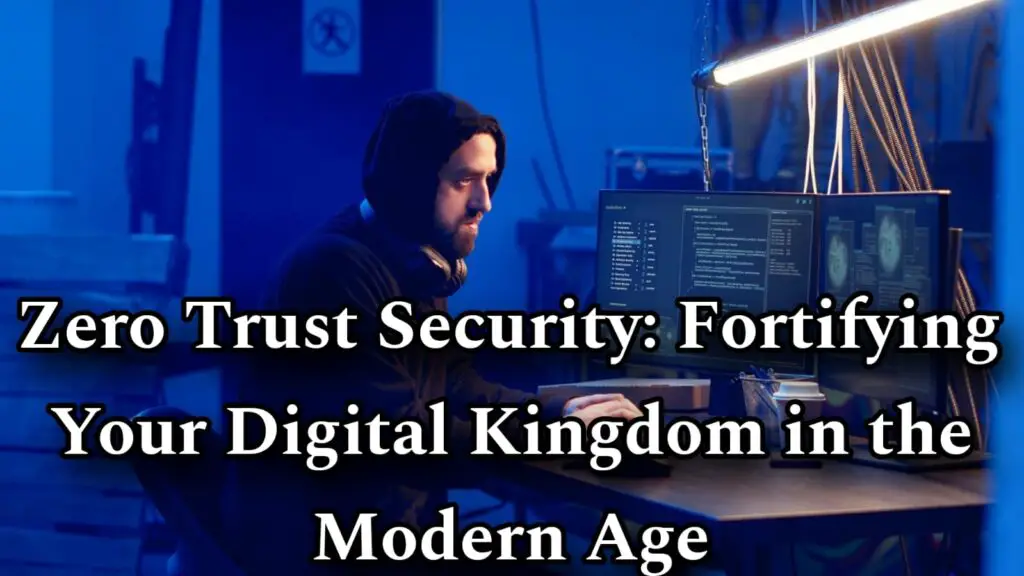Zero Trust Security: Fortifying Your Digital Kingdom in the Modern Age

In today’s ever-evolving threat landscape, traditional castle-and-moat security approaches are becoming increasingly inadequate. Perimeter walls (firewalls) can be breached, and once inside, attackers have free rein. Zero trust security emerges as a powerful defense strategy, constantly verifying users and devices, regardless of location, before granting access to critical resources.
This blog delves into the core principles of zero trust, explores its benefits, and equips you with the knowledge to implement this robust security framework.
Demystifying Zero Trust: Core Principles
Least Privilege Access:
Continuous Verification:
Authentication and authorization are not one-time events. Every access attempt is scrutinized, and user activity is continuously monitored for anomalies.
Micro segmentation:
The network is carved into smaller, isolated segments. This limits the potential damage if a breach occurs, similar to fire doors within a building that prevent flames from engulfing the entire structure.
Strong Authentication:
Let’s see how zero trust principles translate into real-world situations:
Scenario 1: The Cautious Commuter
Traditional Approach:
Sarah, a marketing manager, logs into the company VPN on her laptop at a coffee shop with her username and password. Once connected, she has unrestricted access to the company network, including sensitive marketing data.
Zero Trust Approach:
Sarah attempts to access a marketing campaign report. Here’s the zero trust difference:
MFA Challenge:
She enters her login credentials, but also needs a verification code sent to her smartphone for access. An extra layer of security to ensure it’s really Sarah trying to log in.
Least Privilege Access:
Sarah can only view the specific marketing report relevant to her task, not all marketing data on the server. No unnecessary access granted.
Continuous Monitoring:
In the background, Sarah’s activity while accessing the report is monitored for suspicious behavior. Anomaly detection can identify potential breaches.
Scenario 2: The Granular Cloud
Traditional Approach:
The sales team uses a cloud-based CRM system. Anyone with the login details can access all customer information and functionalities within the CRM.
Zero Trust Approach:
The sales team utilizes single sign-on (SSO) to access the CRM.
Identity Verification:
Only authorized users with valid SSO credentials can even attempt to log in. Zero trust ensures only the rightful people have access.
Micro segmentation:
Within the CRM, user access is further restricted based on roles. For instance, a junior salesperson might only have permission to view basic customer data, while a senior manager can edit pricing configurations. Granular access control minimizes risk.
These scenarios showcase the power of zero trust:
Reduced Attack Surface:
Even if an attacker steals login credentials, they wouldn’t have full access to the network or all functionalities within the cloud application.
Enhanced Adaptability:
Zero trust seamlessly integrates with cloud-based tools and remote work environments, perfectly suited for today’s dynamic work styles.
Improved Security Posture:
The additional layers of verification and access control make it significantly harder for attackers to compromise sensitive data.
Building Your Zero Trust Fortress: Tools and Methods
Implementing zero trust requires a comprehensive approach. Here are some key tools and methods to consider:
Multi-Factor Authentication (MFA):
MFA adds an extra layer of security beyond passwords by requiring a secondary verification factor, like a code from your phone.
Identity and Access Management (IAM):
IAM solutions centralize user identity management and control access privileges across various applications and resources.
Data Loss Prevention (DLP):
DLP tools prevent sensitive data from being accidentally or maliciously leaked or exfiltrated.
Micro segmentation Tools:
These tools create firewalls within your network, isolating different segments to limit the blast radius of a potential breach.
Security Information and Event Management (SIEM):
SIEM systems aggregate log data from various security tools, providing real-time insights and enabling threat detection.
Related posts:
- HP Support Assistance Privilege Escalation CVE-2020-6917
- Another Blue Screen of Death after installing July 2024 month Patch
- CrowdStrike update bricking Windows machines around the world
- CVE-2024-1212 Unauthenticated Command Injection in Progress Kemp LoadMaster
- [Solved] VMware vCenter Server Heap-Based Buffer Overflow Vulnerabilities (CVE-2024-38812 & CVE-2024-38813)
- [Solved] Microsoft Windows Explorer AutoPlay Not Disabled” Vulnerability
- CVE-2024-43491: Microsoft Windows Update Remote Code Execution Vulnerability
- Discover Hidden Browsing Threats: Free Risk Assessment for GenAI, Identity, Web, and SaaS Risks
- [Solved] CVE-2025-26633 Microsoft Windows Management Console (MMC) Improper Neutralization Vulnerability
- [Solved] Windows Cached Logon Credentials Vulnerability

Superb Information